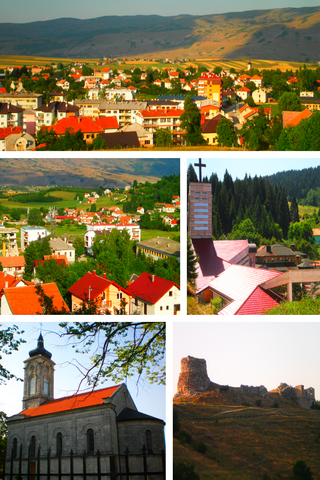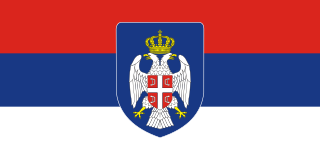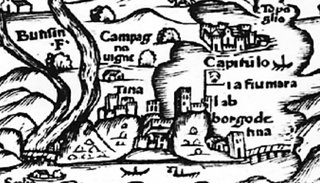This article needs additional citations for verification .(May 2021) |


Kninska Krajina is a geographical and historical region in Dalmatian Hinterland in Croatia, centered around the town of Knin.
This article needs additional citations for verification .(May 2021) |


Kninska Krajina is a geographical and historical region in Dalmatian Hinterland in Croatia, centered around the town of Knin.
Kninska Krajina is situated between Bukovica in the southwest, Lika in the northwest, Drniška Krajina in the south, Cetinska Krajina in the southeast, and Završje (Bosnia and Herzegovina) in the east.
In the 6th century, the region was settled by Slavs (Sklavenoi). Knin itself was first mentioned by Byzantine Emperor Constantine Porphyrogenitus (r. 913–959) as the centre of a parish under Croatian rule. At the request of King Peter Krešimir IV of Croatia (r. 1058–1075), Knin became an episcopal see and the bishop of Knin held a title bishop of Croats (episcopus Chroatorum). Demetrius Zvonimir of Croatia (r. 1075–1089) was seated in the town. There are remains of Serbian churches and monasteries in this region dating from 15th century. This suggest that Serb people lived here for several centuries.[ citation needed ]
In the 15th century, the Ottoman Empire occupied the area resulting in most of the native population fleeing the region. It was largely abandoned and devastated as the Ottoman army advanced towards the north and west. The region was administrated into the Sanjak of Kirka.
By the 17th and 18th centuries, the Austrian Empire managed to thwart the Ottoman advances; meanwhile, the area had been slowly repopulated by Eastern Orthodox Christian Serbs since at least the 15th century. These Serbs had fled the Ottomans and were given lands in exchange for military service in the so-called Military Frontier (the Austro-Hungarian-Ottoman buffer zone).
In 1990, the Serbian autonomous region known as SAO Kninska Krajina was established with a local government, named after this geographical region. This region, along with other Serb-inhabited autonomous regions were merged to form the Republic of Serbian Krajina which sought to remain in union with Serbia and Montenegro upon Croatia's proclamation of independence in 1991. The area was ethnically cleansed of non-Serbs. In 1995, the Croatian army retook the region in Operation Storm, and the majority of the Serb population fled or was displaced. Today, the region is sparsely populated due to few economic opportunities.

At the time of the Roman Empire, the area of modern Croatia comprised two Roman provinces, Pannonia and Dalmatia. After the collapse of the Western Roman Empire in the 5th century, the area was subjugated by the Ostrogoths for 50 years, before being incorporated into the Byzantine Empire.
Krajina is a Slavic toponym, meaning 'country' or 'march'. The term is related to kraj or krai, originally meanings land, country or edge and today denoting a region or province, usually remote from urban centers.

The Military Frontier was a borderland of the Habsburg monarchy and later the Austrian and Austro-Hungarian Empire. It acted as the cordon sanitaire against incursions from the Ottoman Empire.

The Republic of Serbian Krajina or Serb Republic of Krajina, known as the Serbian Krajina or simply Krajina, was a self-proclaimed Serb proto-state, a territory within the newly independent Republic of Croatia, which it defied, and which was active during the Croatian War of Independence (1991–95). It was not recognized internationally. The name Krajina ("Frontier") was adopted from the historical Military Frontier of the Habsburg monarchy (Austria-Hungary), which had a substantial Serb population and existed up to the late 19th century. The RSK government waged a war for ethnic Serb independence from Croatia and unification with the Federal Republic of Yugoslavia and Republika Srpska.

Knin is a city in the Šibenik-Knin County of Croatia, located in the Dalmatian hinterland near the source of the river Krka, an important traffic junction on the rail and road routes between Zagreb and Split. Knin rose to prominence twice in history, as the capital of both the medieval Kingdom of Croatia and briefly of the self-proclaimed quasi-state Republic of Serbian Krajina within the newly independent Republic of Croatia for the duration of Croatian War of Independence from 1991 to 1995.

Bosanska Krajina is a geographical region, a subregion of Bosnia, in western Bosnia and Herzegovina. It is enclosed by a number of rivers, namely the Sava (north), Glina (northwest), Vrbanja and Vrbas. The region is also a historic, economic and cultural entity of Bosnia and Herzegovina, noted for its preserved nature and wildlife diversity.

White Carniola is a traditional region in southeastern Slovenia on the border with Croatia. Due to its smallness, it is often considered a subunit of the broader Lower Carniola region, although with distinctive cultural, linguistic, and historical features.

Vrlika is a small town in inland Split-Dalmatia County, Croatia. The closest large towns are Sinj, Knin, and Drniš. Vrlika was given the status of town in 1997. Vrlika is an underdeveloped municipality which is statistically classified as the First Category Area of Special State Concern by the Government of Croatia.
Podunavlje is the name of the Danube river basin parts located in Croatia and Serbia. Podunavlje is located on the southern edge of Pannonian Basin. In its wider meaning, the Croatian term refers to the area around the entire flow of the river Danube.

The Serbian Autonomous Oblast of Krajina or SAO Krajina was a self-proclaimed Serb Autonomous Region (oblast) within modern-day Croatia. The territory consisted of majority-Serbian municipalities of the Republic of Croatia that declared autonomy in October 1990. It was formed as the SAO Kninska Krajina, but, upon inclusion of additional Serb-populated areas, changed its name simply to SAO Krajina. In 1991 the SAO Krajina declared itself the Republic of Serbian Krajina, and subsequently included the other two Serbian SAOs in Croatia, the SAO Western Slavonia and the SAO Eastern Slavonia, Baranja and Western Syrmia.

Drniš is a town in the Šibenik-Knin County, Croatia. Located in the Dalmatian Hinterland, it is about halfway between Šibenik and Knin.
The History of Dalmatia concerns the history of the area that covers eastern coast of the Adriatic Sea and its inland regions, from the 2nd century BC up to the present day. The earliest mention of Dalmatia as a province came after its establishment as part of the Roman Empire. Dalmatia was ravaged by barbaric tribes in the beginning of the 4th century. Slavs settled in the area in the 6th century, the White Croats settled Dalmatia the following century.
Vojvodina is an autonomous province located in northern Serbia. It consists of the Pannonian Plain in the south, and the Danube and Sava rivers in the north.

Glamoč is a town and the seat of the Municipality of Glamoč in Canton 10 of the Federation of Bosnia and Herzegovina, an entity of Bosnia and Herzegovina. It is situated in southwestern Bosnia and Herzegovina, at the foothills of Staretina and Velika Golija mountains, and on the edge of the central part of the Glamočko Polje.

The Serbian Autonomous Oblast of Western Slavonia was a Serbian self-proclaimed Serb Autonomous Region (oblast) within Croatia. It was formed on 12 August 1991 and was subsequently included into the Republic of Serbian Krajina. It was eliminated and reintegrated into Croatia in May 1995, during Operation Flash.

Bukovica is a geographical region in Croatia. It lies in northern Dalmatia, with Lika to the north, Kninska Krajina to the east, and Ravni Kotari to the southwest.

Knin Fortress is located near the tallest mountain in Croatia, Dinara, and near the source of the river Krka. It is the second largest fortress in Croatia and most significant defensive stronghold, and a historical town in the Šibenik-Knin County in the Dalmatian Hinterland. The construction of the fortress started as early as 9th century, while the current state was brought up in 17th and 18th centuries. It reached its peak during the reign of Demetrius Zvonimir, King of Croatia from 1076, as it served as a political center of the Croatian Kingdom under him.

Eastern Slavonia, Baranja and Western Syrmia, commonly abbreviated as Eastern Slavonia, was a short-lived Serb parallel entity in the territory of Croatia along the Danube river.
The term Vlachs was initially used in medieval Croatian and Venetian history for a Romance-speaking pastoralist community, called "Vlachs" and "Morlachs", inhabiting the mountains and lands of the Croatian Kingdom and the Republic of Venice from the early 14th century. By the end of the 15th century they were highly assimilated with the Slavs and lost their language or were at least bilingual, while some communities managed to preserve and continue to speak their language (Istro-Romanians).

The siege of Knin was a siege of the city of Knin, the capital of the Kingdom of Croatia, by the Ottoman Empire in 1522. After two failed attempts in 1513 and 1514, Ottoman forces led by Ghazi Husrev Bey, sanjak-bey (governor) of the Sanjak of Bosnia, launched a major offensive on southern Croatia in the spring of 1522. In May, his forces, reinforced with troops from the Sanjak of Herzegovina and Constantinople, besieged the Knin Fortress.